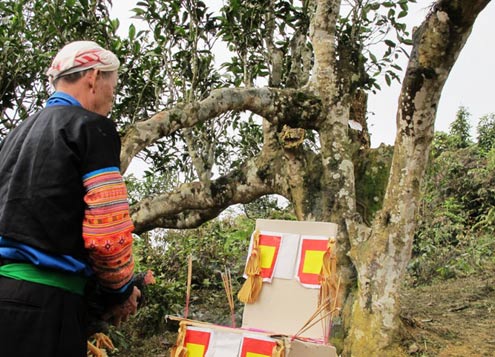Tea Trees: A Pleasantly Different Tourism

Hoang Lien Son is made up of many naturally beautiful sites that tourists are easily curious about and want to visit to.
One favorite tourist destination is the Hoang Lien Son Range, a resort town of Sa Pa in the Northern Highlands Province of Lao Cao. It is where Mt. Fansipan can be found, the highest peak in Vietnam. At 3,143 meters high, it is also among the highest mountains in Southeast Asia. Aside from its incredible height, Mt. Fansipan is also quite long covering 180 kilometers of land area and actually connects the three provinces of Lao Cai, Lai Chau and Yen Bai.
But there's a fairly new and different attraction in the area that is yet unknown to many both domestic and foreign visitors alike. Not your typical tourist spot, Yen Bai's Suoi Giang Commune is home to 190 hectares of old tea trees. Located 1,371 meters above sea level, the tea trees have trunks that are quite big that it takes about two people to be able to fully embrace it. Naturally, the livelihood of the local residents is producing tea. In fact, Suoi Giang tea is now a famous brand in many provinces.
It is in this richness and abundance of both the tea trees themselves and what they bring to the community that every October or beginning of the year, the H'mong people celebrate a ceremony of gratitude thanking the ancient trees for making their lives better. This ritual is actually a one-of-a-kind activity for the ethnic group and a unique experience for the visitors as well. The ceremony is performed by a thay cung (shaman), a position not easily earned. To become a shaman, one must be able to read the prayers in the now rare H'mong language, a person of high morals, and trusted by the community.
The ceremony is performed on the oldest tea tree in the area, 300 years old located at Giang B Village. A simple altar made of bamboo covered with giay ban is placed under the tree. Giay ban is a kind of paper made by the ethnic minority people in Lao Cao Province themselves specifically for their traditional customs or rituals. Red and yellow papers representing Earth, the gods and ancestors are stuck around the altar. A rooster is offered as a sacrifice, prayed to become the messenger between heaven and earth. After the ritual, the rooster is cooked and eaten, accompanied by ruou ngo (rice wine).
Hoang Lien Son National Park is a tea forest discovered by Tran Ngoc Lam, a long-time tour guide at Mt. Fansipan. The place remained unknown until he brought a Japanese engineer to the site in 2003. A tea lover himself, he then spread the wonderful discovery, which actually landed in the local media. But even today, not many people know of the tea forest. Moreover, the trees are not cuddled up in one area, but distributed at different heights of between 2,200-2,800 meters. This means that walking to the trees could take up to two hours, a difficult one at that. One has to be really appreciative of tea to be really interested in visiting the place. But after picking tea at the site itself and discovering its “sweet, gentle, and pleasant” taste, it always makes the trip worthwhile, even drawing significant visitors and new tea enthusiasts after.









